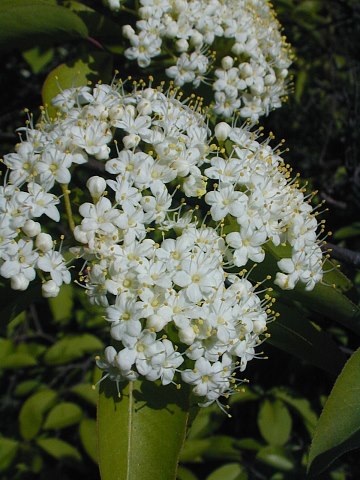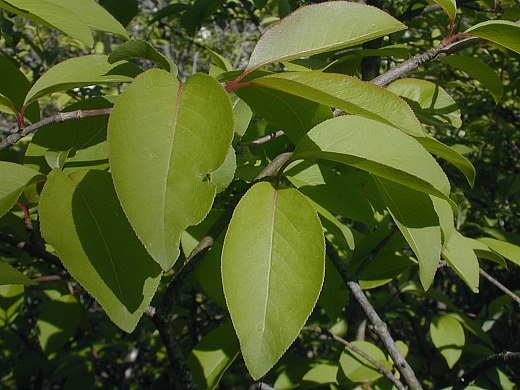Description: This is a branched woody shrub or small tree up to 15' tall. The young bark of small branches is gray and slightly rough, while the old bark of the trunk or larger branches is grey and rough with flat-topped plates. The opposite leaves are up to 3" long and 1" across; they are ovate or ovate-obovate, glabrous on both their lower and upper sides, and finely serrated along their margins. The slender petioles are up to 1" long and reddish. The buds of these leaves are short.

Cymes of flowers about 3-5" across develop from the axils of the leaves; each cyme is much branched, but sessile at the base. Each flower is about ¼" across; it has 5 white petals that are well-rounded and longer than the sepals. There are 5 long stamens with slender white filaments and yellow anthers, and a small pistil at the center of the flower that is cream-colored at the base. The blooming period occurs from mid- to late spring. The flowers have a strong and pleasant fragrance; they are produced at about the same time as the leaves. Each flower is replaced by a fleshy ovoid drupe about 1/3" (8 mm.) long; this drupe becomes blue-black at maturity, sometimes with a whitish bloom. Inside each drupe, there is a single stone (a seed with a hard coat) that is flat on one side and convex on the other. The drupes are sweet and edible, although somewhat thin-fleshed because of their stones. The root system consists of a branching woody taproot.
Cultivation: The preference is light shade to partial sun, mesic to dry conditions, and soil that is loamy, clayish-loamy, sandy-loamy, or somewhat rocky. This shrub can assume somewhat irregular shapes, depending on lighting conditions.
Range & Habitat: The native Blackhaw Viburnum is occasional to locally common in most areas of Illinois; it is less common or absent in parts of NW and southern Illinois. Habitats include rich mesic woodlands, upland woodlands, thinly wooded bluffs, rocky wooded slopes, limestone glades, woodland borders, and areas along woodland paths. This species is found in deciduous woodlands, particularly where oaks are dominant. It can decline in abundance when a woodland is invaded by non-native Honeysuckle shrubs, such as Lonicera maackii (Amur Honeysuckle) and Lonicera tartarica (Tartarian Honeysuckle).
Faunal Associations: The nectar and pollen of the flowers attract primarily small bees and flies, but also other flower-visiting insects. This includes cuckoo bees (Nomada spp.), mason bees (Osmia spp.), Halictid bees (Lasioglossum spp., Sphecodes spp., & others), plasterer bees (Colletes spp.), Andrenid bees (Andrena spp.), Vespid wasps, flower flies (Syrphidae), dance flies (Empis spp., Rhamphomyia spp.), bee flies (Bombylius spp.), Tachinid flies, blow flies (Lucilia spp.), Muscid flies, various butterflies and skippers, and various beetles (Robertson, 1929; Steury et al., 2009; Lovell, 1900). Other insects feed destructively on Blackhaw Viburnum and other viburnum shrubs (Viburnum spp.). This latter group of insects include the Viburnum Leaf Beetle (Pyrrhalta viburni), weevils, larvae of various gall flies, plant bugs, aphids, larvae of sawflies, larvae of many moths, and larvae of some butterflies, including the Spring Azure (Celastrina ladon). Moths that are oligoletic feeders on Viburnum shrubs include The Green Marvel (Agriopodes fallax) and Unsated Sallow (Metaxaglaea inulta). The Insect Table provides a more detailed list of these insects. Among vertebrate animals, birds make the most use of these shrubs as a source of food (fruits), protective cover, and nesting habitat. The fruits are consumed by both upland gamebirds and songbirds, including thrushes and vireos (see Bird Table). Mammals using Viburnum shrubs as a source of food include the White-tailed Deer (foliage, twigs), Eastern Chipmunk (fruits), White-footed Mouse (fruits, seeds), Deer Mouse (fruits, seeds), and American Black Bear (fruits); see Martin et al. (1951/1961), Hamilton (1941), Romain et al. (2013), Noyce & Coy (1990), and Mosnier et al. (2008).
Photographic Location: An upland wooded area along a path at Busey Woods in Urbana, Illinois.

Comments: This is an attractive shrub, particularly during the spring when the flowers bloom. It can be used in landscaping and other horticultural purposes. Blackhaw Viburnum is fairly easy to identify. The most similar species is Viburnum lentago (Nannyberry), which has similar white flowers and blue-black drupes. However, the leaves of Nannyberry have longer tips than those of Blackhaw Viburnum. Other Viburnum spp. have leaves that are smooth or coarsely serrated, whereas the leaves of Blackhaw Viburnum are finely serrated. Some species in this genus, for example Viburnum dentatum (Arrow-Wood), have straight branches and flowers with an unpleasant fragrance. The branches of Blackhaw Viburnum are more crooked and the fragrance of its flowers is sweet and pleasant.